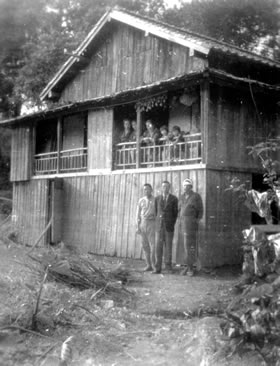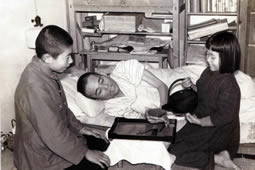Kayano's Summer
(Supplementary explanation) |
 |
| From right: Midori (her mother), Kayano, Makoto (her brother),
and Dr. Nagai (her father) |
Kayano was born on August 18, 1941 in Ueno-machi, Nagasaki City.
There were five members in her family: herself, her father, her mother, her elder
brother named Makoto (age 10 at the time of the A-bombing), and her grandmother.
Kayano’s father was Takashi Nagai, a doctor who worked at the Physical Rehabilitation
Department (present radiology department) of Nagasaki Medical College (now the
Nagasaki University School of Medicine). Dr. Nagai was found to be suffering
from leukemia, due to occupational exposure to a large dose of radiation from
the X-ray examinations and other similar activities he had been engaged in for
many years; he was thought to have only three years to live. After experiencing
the A-bomb disaster, he wrote many books, including “The Bells of Nagasaki (Nagasaki
no Kane),” which disseminated the actual situation of A-bombed Nagasaki to people
around the world. Kayano’s mother, Midori, was from a traditional and devout
Catholic family. She was very hard working and particularly good at needlework.
The atomic bomb, dropped on August 9, transformed the life of this close family. |
| Dr. Nagai’s Activities to Relieve A-bomb Victims |
 |
| House in Koba, to which Kayano (pictured second from right)
and her brother Makoto had been evacuated for safety. In front of the house is
her father, Dr. Nagai, with a bandage around his head. |
Kayano’s father, Dr. Takashi Nagai, was in the main building
of the Nagasaki Medical College Hospital, only 700 meters from the hypocenter,
when an atomic bomb was dropped over Nagasaki. He saw a blinding flash of light
and was swept away by a ferocious blast.
(From “The Bells of Nagasaki”)
“And before my eyes the flash of blinding light took place. It was like a thunderbolt
in a clear sky. A bomb must have fallen at the very entrance to the university,
I thought. I immediately tried to throw myself to the ground, but before I could
do so, the glass of windows smashed in and a frightening blast of wind swept
me off my feet into the air―my eyes wide open. Pieces of broken glass came in
like leaves blown off a tree in a whirlwind.”
Dr. Nagai suffered numerous cuts on the right side of his body,
as a result of flying splinters of glass. He received a deep cut on his right
temple, above his right eye and around his right ear, which caused heavy bleeding.
Nevertheless, together with other surviving doctors and nurses,
Dr. Nagai devoted his time to treating the injured and other victims. Three days
later, when relief activities were caught up for the time being, he finally returned
home. In the ruins of the house he found his wife, who had died and become soft
ashes, and her rosary and chain.
The next day, Dr. Nagai went to a house in Koba, a rural region
to which his children had been evacuated and where they waited for him, to establish
the headquarters of a rescue group that came with him from the hospital. |
 |
| Kayano’s family. She is pouring spiced sake into a cup for
her father, to celebrate the New Year. |
In the following year, as his leukemia worsened, Dr. Nagai became
bed-ridden. Even in such a condition, he continued to write, to make a living
and to tell people around the world about the horrors of the atomic bomb. Kayano’s
elder brother Makoto, was living in a boarding house to attend a national elementary
school in Omura City. In 1948 a house was built for Kayano’s family, with donations
from Catholics. The tiny house comprised a two-tatami mat room (about four square
meters in area) and a corridor with a boarded floor. The house was named Nyokodo
(As Yourself Hermitage), after the Christian maxim "Love others as you love
yourself.” In the house, Kayano lived with her father and elder brother, who
was then enrolled in a junior high school in Nagasaki.
At Nyokodo, Dr. Nagai continued his efforts to encourage people,
especially children, who had experienced the shock of the A-bomb experience.
For example, with royalties from his book he erected a memorial “Anokora no Hi
(Children’s Memorial)” in memory of the children killed by the atomic bomb. Dr.
Nagai also helped establish a children’s private library, called “Uchira no Honbako
(Our Book Case).”As well, he bought cherry seedlings and had them planted at
nearby schools, so as to regenerate the atomic wasteland of Urakami into a district
where beautiful flowers bloom. However, he passed away at the age of 43, in 1951.
Although his two young children had lost their parents, they
were brought up with love and care by Dr. Nagai’s younger brother and his wife,
as well as the other people around them. Makoto later grew up to become a journalist
and Kayano grew up to become a teacher, carrying out the intentions of their
deceased father and mother. |
|